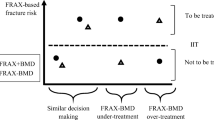Abstract
Summary
This study was designed to determine a FRAX intervention threshold in postmenopausal Thais, based on a history of hip fracture. The optimal FRAX thresholds for hip fracture were 4.9% (without BMD) and 4% (with BMD), while the thresholds for major osteoporotic fracture were 9.8% (without BMD) and 8.9% (with BMD).
Introduction
Fracture Risk Assessment Tool (FRAX) has been widely used as an intervention threshold for initiating osteoporosis treatment. However, there is a lack of data to validate the threshold in Thai population.
Methods
A cross-sectional study was conducted from January 2014 to February 2019. Postmenopausal women in the Northeast of Thailand whom has bone mineral density (BMD) measured using dual-energy X-ray absorptiometry (DXA) in the study period were recruited. Participants who had previously received anti-osteoporotic treatment were not eligible. FRAX score, both with and without BMD, was calculated using a Thai reference. Prevalent hip fracture was identified by reviewing the ICD-10 diagnosis from the hospital database during the study period. The receiver operating characteristic (ROC) curve and Youden index were used to determine the FRAX threshold in predicting hip fracture, based on the rationale that women with a prevalent hip fracture would be eligible for treatment.
Results
A total of 2872 postmenopausal Thai women were recruited, with 45 sustained a recent hip fracture. In association with hip fracture, the optimal FRAX thresholds for hip fracture without and with BMD were 4.9% and 4%, respectively, with 71.1% sensitivity and 83.3% specificity, and 82.2% sensitivity and 78.6% specificity, while the optimal FRAX thresholds for major osteoporotic fracture (MOF) without and with BMD were 9.8% and 8.9%, respectively, with 75.6% sensitivity and 77.0% specificity, and 86.7% sensitivity and 70.9% specificity.
Conclusion
An optimal intervention threshold based on FRAX of hip fracture and MOF in postmenopausal Thai women is slightly different from the standard recommendation, which confirmed the marked variations of thresholds across ethnicities. The proposed threshold should be considered as new cutoff for initiating osteoporosis treatment in postmenopausal Thais.

Similar content being viewed by others
References
Cosman F, de Beur SJ, LeBoff MS, Lewiecki EM, Tanner B, Randall S et al (2014) Clinician’s Guide to prevention and treatment of osteoporosis. Osteoporos Int 25(10):2359–2381
Harvey N, Dennison E, Cooper C (2010) Osteoporosis: impact on health and economics. Nat Rev Rheumatol 6(2):99–105
Wainwright SA, Marshall LM, Ensrud KE, Cauley JA, Black DM, Hillier TA et al (2005) Hip Fracture in women without osteoporosis. J Clin Endocrinol Metab 90(5):2787–2793
Siris ES, Brenneman SK, Miller PD, Barrett-Connor E, Chen Y-T, Sherwood LM et al (2004) Predictive value of low BMD for 1-year fracture outcomes is similar for postmenopausal women ages 50–64 and 65 and older: Results from the National Osteoporosis Risk Assessment (NORA). J Bone Miner Res 19(8):1215–1220
FRAX ® FRAX – Fracture Risk Assessment Tool [Internet]. [cited 2021 Jan 25]. Available from: https://www.sheffield.ac.uk/FRAX/tool.aspx?lang=th
Kanis JA, Oden A, Johnell O, Johansson H, De Laet C, Brown J et al (2007) The use of clinical risk factors enhances the performance of BMD in the prediction of hip and osteoporotic fractures in men and women. Osteoporos Int 18(8):1033–1046
Johansson H. FRAX- vs. T-score-based intervention thresholds for osteoporosis. Osteoporos Int. 2017 Nov;28(11):3099–105.
Songpatanasilp T, Sritara C, Kittisomprayoonkul W, Chaiumnuay S, Nimitphong H, Charatcharoenwitthaya N et al (2016) Thai Osteoporosis Foundation (TOPF) position statements on management of osteoporosis. Osteoporos Sarcopenia 2(4):191–207
Kanis JA, Harvey NC, Cooper C, Johansson H, Odén A, McCloskey EV. A systematic review of intervention thresholds based on FRAX : a report prepared for the National Osteoporosis Guideline Group and the International Osteoporosis Foundation. 2017;101.
Tosteson ANA, Melton LJ, Dawson-Hughes B, Baim S, Favus MJ, Khosla S et al (2008) Cost-effective osteoporosis treatment thresholds: the United States perspective. Osteoporos Int 19(4):437–447
Lekamwasam S (2013) Sri Lankan FRAX model and country-specific intervention thresholds. Arch Osteoporos 8(1–2):148
Chandran M (2018) FRAX® based intervention thresholds for management of osteoporosis in Singaporean women. Arch Osteoporos 13(1):130
Zhang Z, Ou Y, Sheng Z, Liao E (2014) How to decide intervention thresholds based on FRAX in central south Chinese postmenopausal women. Endocrine 45(2):195–197
Fujiwara S, Nakamura T, Orimo H, Hosoi T, Gorai I, Oden A, et al. Development and application of a Japanese model of the WHO fracture risk assessment tool (FRAXTM). Osteoporos Int. 2008;7.
Lekamwasam S, Chandran M, Subasinghe S (2019) Revised FRAX®-based intervention thresholds for the management of osteoporosis among postmenopausal women in Sri Lanka. Arch Osteoporos 14(1):33
Kanis J (2013) Commentary on guidelines on postmenopausal osteoporosis - Indian Menopause Society. J -Life Health 4(2):129–131
Chan D-C, McCloskey EV, Chang C-B, Lin K-P, Lim LC, Tsai K-S et al (2017) Establishing and evaluating FRAX® probability thresholds in Taiwan. J Formos Med Assoc Taiwan Yi Zhi 116(3):161–168
Chen JS, Simpson JM, Blyth FM, March LM (2014) Managing osteoporosis with FRAX® in Australia: proposed new treatment thresholds from the 45&Up Study cohort. Bone 69:148–153
Kanis JA, Johansson H, Oden A, McCloskey EV. The distribution of FRAXÒ-based probabilities in women from Japan. J Bone Min Metab. 2012;6.
Pongchaiyakul C, Songpattanasilp T, Taechakraichana N (2008) Burden of osteoporosis in Thailand. Int J Rheum Dis 11(4):335–340
Pongchaiyakul C, Leerapun T, Wongsiri S, Songpattanasilp T, Taechakraichana N (2012) Value and validation of RCOST and TOPF clinical practice guideline for osteoporosis treatment 95(12):8
Chotiyarnwong P, Harvey NC, Johansson H, Liu E, Lorentzen M, Kanis JA et al (2019) Temporal changes in access to FRAX® in Thailand between 2010 and 2018. Arch Osteoporos 14(1):66
Hoang DK, Doan MC, Mai LD, Ho-Le TP, Ho-Pham LT. Burden of osteoporosis in Vietnam: an analysis of population risk. PLos One. 2021;16(6):e0252592.
Author information
Authors and Affiliations
Corresponding author
Ethics declarations
Conflict of interest
None.
Additional information
Publisher’s note
Springer Nature remains neutral with regard to jurisdictional claims in published maps and institutional affiliations.
Rights and permissions
About this article
Cite this article
Sribenjalak, D., Charoensri, S. & Pongchaiyakul, C. An optimal intervention threshold of FRAX in postmenopausal Thai women. Arch Osteoporos 17, 21 (2022). https://doi.org/10.1007/s11657-022-01058-0
Received:
Accepted:
Published:
DOI: https://doi.org/10.1007/s11657-022-01058-0




